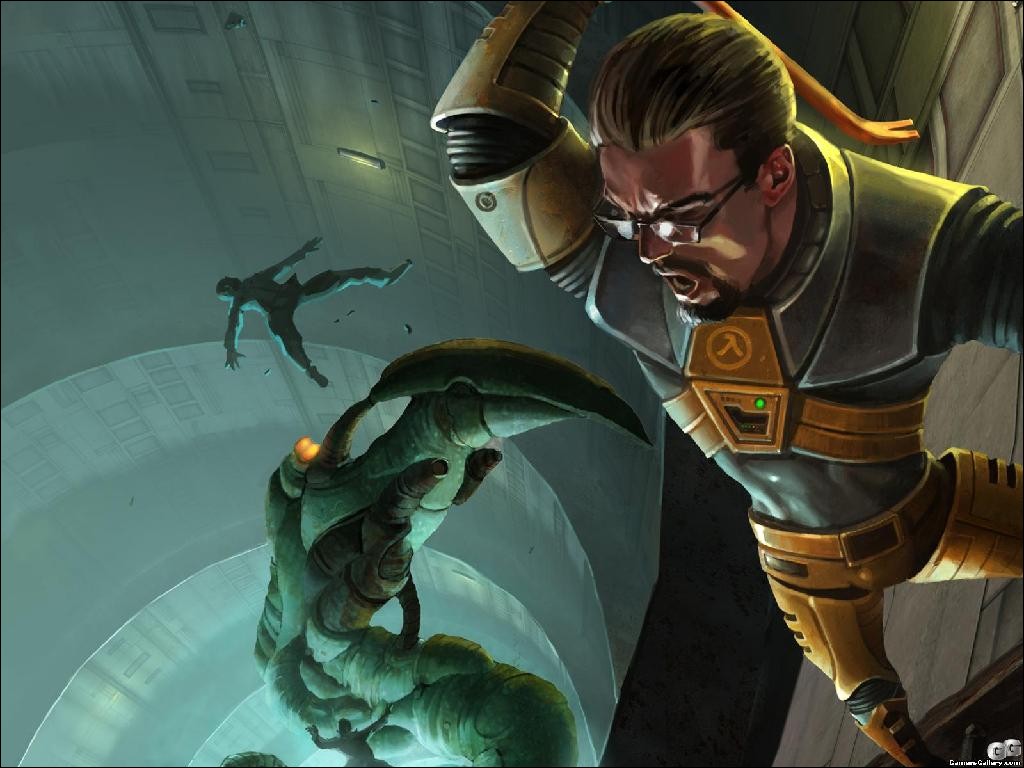

If you’re a fan of video games, specifically PC games, you most likely have played Half Life. If you haven’t, it’s a sci-fi first person shooter released in 1998 by Valve, and one of the most important video games in history. Here’s the short version: you play as Gordon Freeman, a physicist in a high tech protective suit, who survives a freak accident in the Black Mesa research facility that results in extra-dimensional creatures infesting the complex. You then fight your way out with a variety of scavenged weapons. It may not sound like much, but at its time the game was revolutionary for introducing a lot of game design elements now taken for granted in first person shooters, including an emphasis on immersion. The entire story is told through your eyes, with no cut scenes and minimal screen clutter. It also ushered in a massive game community that would modify Half Life to create entirely new games, many of which would go on to be massively popular in their own right (the original Counter Strike, for example).
The fruitful culmination of eight years of labor from talented and dedicated fans, Black Mesa is a complete recreation of the original Half Life, rebuilt in the Source game engine that powers modern Valve games like Half Life 2, Portal and Left 4 Dead. When it was announced, the massive undertaking was met with skepticism. At several points, the project was presumed canceled. Who would be surprised that an amateur reconstruction of an entire game would be scrapped? Yet Black Mesa was released last Friday, and though incomplete, it is a surprisingly polished piece that more than does the original justice.
The game begins with you taking in the sights of the Black Mesa Research Facility as you travel in a monorail car. The creators take the opportunity to flex some muscle in recreating this scene from the original game, showing off the highlights of the technical improvements of the Source engine, including impressive outdoor desert environments, dynamic indoor lighting and realistically moving construction machines. The graphical improvements are most obvious when looking at the human characters. The Source engine has always lent itself well to creating visually pleasing, if not necessarily photo-realistic, people. Where the models in the original somewhat resembled paper cut outs, the characters of Black Mesa appear, move and emote realistically. In particular, characters who play major parts in Half Life 2 but appeared as generic models in the first game are recreated with visually distinct models — a nice touch that helps this version seamlessly connect the original and the sequel.
Unfortunately, the voice acting for these characters is one of the few flaws in this game, and where otherwise polished production show some amateur scuffs. While the voices are crisp, and clearly professionally recorded, the actual acting ranges from serviceable to cartoonish to outright bad. Admittedly the original game lacked stellar voice acting, but it would have been nice for this recreation to update the voice acting as well as the graphics. In regards to the graphics, while the game undeniably looks better than its inspiration, I must admit that the Source engine’s graphics are beginning to look dated. Valve has implemented several new technologies into the engine over the years to keep it looking somewhat fresh and up-to-date, including advanced lighting techniques, water shaders and the like, but these tricks only do so much to improve a game engine that is roughly eight years old. Black Mesa looks good, but it won’t necessarily ‘wow’ you unless you’re comparing it to Half Life (in which case, admittedly, it will blow your mind).
The developers have done an astonishing job of faithfully recreating the levels from the first game, down to some extremely minute details such as the placement of books and switches. Personally, I did not expect the aliens, which were mostly absent in the sequels and thus had to be remodeled from scratch, to be of such high quality. One scene, featuring a gargantuan, unstoppable alien chasing you through a tunnel, felt a lot more tense and pulse pounding with the updated graphics and physics, as cars explode and pieces of metal go flying. The improved presentation really does add to the immersion, both for high adrenaline action, as well as for stealth sections where you’re trying to ambush the enemy. Complex lighting and shadows reinforce the lone-survivor atmosphere, and the puzzles are greatly improved by the advanced physics that have become the signature feature of the Source engine (Yes, puzzles! It’s not just shooting!). In addition, the soundtrack for this game is a fantastic update to the lackluster music from the original game, and illustrates a marriage of both talent and polish.
For those who have played the original Half Life, Black Mesa holds few surprises, but that’s a good thing. After all, their goal was to update one of the greatest games out there, and they succeeded. Well, almost. The developers have yet to recreate Xen, an alien world that comprises the last 15-20 percent of the original game, although it will be released later. Regardless, Black Mesa is an incredible update to a historic game and is absolutely free: there’s no reason not to play this labor of love. If you played the original, prepare for a nostalgic treat. If you didn’t, just play it. Stop thinking about it and do it.